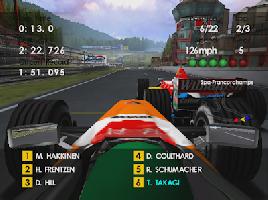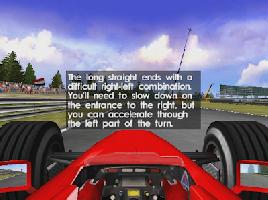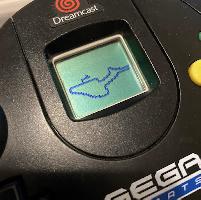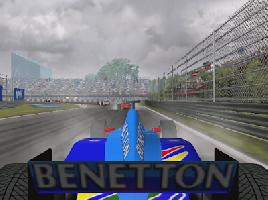
For a console that lived and died in such a relatively short span of time, the Dreamcast sure did rack up a veritable bounty of top class racers. No doubt if you're a fan of either the genre, the Dreamcast, or both - as I am - then you don't need me to list the big hitters here. If you're not au fait though, rest assured that if you're new to the Dreamcast and you're partial to navigating large, wheeled boxes down tarmac lanes at wholly ridiculous speeds, then you're in for a treat.

As a sub-genre of racing games then, the Formula 1 fan is equally well catered for when it comes to the Dreamcast library. There are no less than 5 separate F1 titles on the platform (well, 6 if you count Spirit of Speed, but in truth that's barely a game; and 7 if you count Super Speed Racing / CART Flag to Flag), each offering its own unique take on the real world motorsport and we have covered them all -
albeit briefly
- here at the Junkyard in the semi-distant past. But in this retrospective I wanted to focus on the game many aficionados consider to be the pinnacle of F1 racing on the Dreamcast, and also a title - it turns out - which has a fairly interesting origin story and an equally curious legacy: F1 World Grand Prix II for Dreamcast.

Before we even attempt to discuss the game's many positives and numerous failings, I think it is worth investigating the history of the F1 World Grand Prix franchise, and the enigmatic firm behind it - Video System. Video System Co Ltd was a Japanese developer and publisher that began putting out
games in the 1980s
in both the arcades and on home consoles such as the TurboGrafx-16 and Nintendo Entertainment System. Video System's foray into the world of F1 games began in 1991 with F1 Grand Prix on the Super Nintendo and in arcades; and this game spawned two sequels - F1 Grand Prix: Part II and Part III in 1992 and 1993 respectively.
|
 |
| F1 Grand Prix: Part II is playable on MAME
|
It was in 1998 that the series was rebooted as F1 World Grand Prix for the Nintendo 64, a game which was developed in partnership with a studio called Paradigm Entertainment. It's here where things start to get interesting, as the Nintendo 64 game and its 1999 sequel (F1 World Grand Prix II) are completely separate titles to the games that made an appearance on the Dreamcast, and they share very little other than a name. The Dreamcast version of F1 World Grand Prix was developed in-house by Video System, and received the suffix 'for Dreamcast,' simply to differentiate it from the Nintendo 64 version.
|
 |
| The N64 version of F1 World Grand Prix
|
Likewise, that game's sequel - the subject of this very article - was developed by Video System in a silo away from the Nintendo 64 version of F1 World Grand Prix II and comparing the two titles side by side demonstrates just how different they are in almost every way. If they didn't share a title and a publisher, you'd be forgiven for thinking they were from totally separate franchises that featured an FIA license. It gets even more curious when you learn that neither sequel was given a US release (though the prequels were), and the Dreamcast game was distributed in Europe by Konami.
|
 |
| Distributed exclusively by Konami...for some reason
|
There's precious little information available online about why this was, as Video System was still in a position to distribute its own games in the early 2000s; so why Konami - of all firms - was engaged to distribute F1 World Grand Prix II for Dreamcast in European markets is something of a mystery. Are you still with me here? OK - it gets a bit more interesting now. According to recently published information
over at the Lost Media Wiki
, a third game in the Nintendo 64 series - imaginatively titled F1 World Grand Prix III - was around 80% complete and fully playable before it was cancelled due to the console's waning popularity.
There's no information on whether a similar 'for Dreamcast' iteration of F1 World Grand Prix III was in development, but due to the totally divorced development cycles of the two previous games, I'd wager it wasn't...and just like that, F1 World Grand Prix III for Dreamcast is brought into existence and instantly goes the way of Geoff Crammond's Grand Prix 3 Dreamcast port. Phew...who knew dusty old F1 games could be so interesting/boring (delete as applicable)?
|
 |
| The Game Boy Color recieved two F1 World Grand Prix games
|
The story doesn't end there though, as Video System was clearly still keen to break the lucrative Game Boy Color and PlayStation markets. To attempt this, Video System took the F1 World Grand Prix name and charged ITL and Eutechnyx respectively to develop entries for respective platforms. The Game Boy Color games (there are two on the GBC) are widely regarded as pretty good; while the PlayStation game (which was also ported to Windows and published by Eidos) was considered to be fairly lacklustre compared to the other F1 offerings from Bizarre Creations and Psygnosis on Sony's system. And so ends the long and storied (and bloody confusing!) story of the - now dormant since Video System folded in 2006 - F1 World Grand Prix series.


As a further footnote, it is worth mentioning that Video System also worked with Ubisoft to publish F1 Racing Championship on Dreamcast and various other platforms, so it is fairly obvious that somebody working there had a bit of a thing for F1 games. But that's enough of that. Let us now turn our attention fully to the main event - F1 World Grand Prix II for Dreamcast.


Released in 2000, the game is based on the 1999 Formula One World Championship and as such features all of the circuits, teams and drivers that took part (although neither Stéphane Sarrazin or Mika Salo are included as playable drivers - more on this later). As you'd expect, F1 World Grand Prix II for Dreamcast has the full FIA license and features a traditional Championship mode alongside Single Race and Time Attack options. There's also a Tutorial mode, but rather than task the player with actually driving a course and completing tasks ala Gran Turismo's licenses (braking, accelerating, cornering etc.) the game simply shows an AI vehicle driving around the circuit and text pops up on the screen at various points to explain the best vehicle setup to successfully negotiate the section. It's an interesting addition, but also represents a missed opportunity to ease players in to the unforgiving nature of the handling model.


Alongside these main gameplay options, there are a couple of nice additional modes which bolster the overall content package provided. The first is a Gallery which allows you to inspect a polygonal model of the vehicles, read detailed profiles of the drivers (spoiler: they all seem to enjoy mountain biking) and also - and quite bizarrely - gives full address, contact details and phone/fax numbers for all of the teams involved. Just seems odd that F1 teams would want to dox themselves like this...although 2000 was a different time I guess. The other mode worth mentioning is Broadcast, where an accurate simulation of the races from the 1999 season can be viewed from the actual camera angles used during the TV broadcasts.


It looks great and really shows off the level of visual detail crammed into the environments; however there is a slightly odd omission. Earlier I mentioned drivers Stéphane Sarrazin and Mika Salo, both of whom took part in a handful of races throughout the 1999 season (with Salo standing in for the injured Michael Schumacher at one point). However if you simulate the races they were involved in, the driver they replaced is named as taking part. It's a tiny irregularity and I imagine there are approximately zero other people on planet Earth right now who give even the slightest hint of a toss about this oversight, but I thought it worth mentioning.
I've already mentioned that the environments look great so I will continue that thread - F1 World Grand Prix II for Dreamcast looks lovely. All of the circuits, the trackside furniture, grandstands, crowds, vehicles...it all looks fantastic and is clearly a generational leap ahead of the Paradigm Entertainment developed Nintendo 64 version. That said, it isn't perfect. There is some pretty brutal 'level of detail' (or 'LOD' - thanks Digital Foundry) pop in, where vehicles and scenery are swapped for lower quality models when they get a certain distance from the 'camera,' and it can be very noticeable in replays. There is no ambient occlusion either (I'd imagine - I don't even know what that is, but it always sounds impressive when they mention it). Also, there appears to be an odd glitch when the game is played from any of the first person views, where camera flashes from the crowds seem to fire off at the edge of the screen in succession as you turn. It is quite difficult to describe, but once you notice it, it is impossible to unsee.
The vehicles too look superb - they are modelled in meticulous detail, right down to the wing shapes and the various sponsors (check out the accurate PlayStation branding on the Prost liveries) and even driver-accurate fully modelled steering wheels. Another nice touch is the effect employed on the tyres - if you look closely you'll spot the optical illusion which occurs in real life where the markings on the tyres appear to 'reverse' as the wheels spin faster, until eventually the lettering simply becomes a blur. F1 World Grand Prix II for Dreamcast is full of these nice little incidental details.


Perhaps the biggest negative when it comes to F1 World Grand Prix II for Dreamcast's visuals though, is the somewhat erratic frame rate. It is far from unplayable and the game does a good job of staying fairly stable for most of the time, but when things heat up and there are multiple vehicles jostling on-screen, or lots of particle effects or spray from wet tires is being kicked up, the frame rate takes a tumble and it really detracts from the overall experience. On the one hand this game is a true demonstration of just how much more advanced the Dreamcast was compared to its contemporary competition, but on the other hand it is also a perfect demonstration of how games can look gorgeous in still screenshots but induce seizures when seen in motion. OK, it's not that bad and perhaps I'm being overly harsh on it simply as I can now, in 2021, enjoy F1 2021 on an Xbox Series X in 4K at a solid 60fps; but I don't recall F1 World Grand Prix II for Dreamcast being anywhere near as choppy when I originally played it back in 2000. Time to get my rose tinted spectacles prescription updated I think.
Stutters aside though, Video System's title offers a solid experience for F1 fans. The full championship offers all the tinkering options you could ever want, along with full race weekend sessions and qualifying. There are numerous options to change how the game assists vehicle handling (be that in terms of acceleration, braking or steering) and it is worth trying to play with these aids turned on as a newcomer. That's because the difficulty level can be fairly brutal initially, and it's where a decent tutorial would have been welcomed.


Analogue controls for both acceleration and braking are something of a necessity when the vehicles are as prone to spinning out as they are in F1 World Grand Prix II for Dreamcast, but with time and patience mastery of the handling model can be achieved and at that point the fun can truly begin. Races which can feel punishing initially - not just because of the rival AI, but also because of the unforgiving controls - lend an air of accomplishment once the controls are grasped, and of course there is the option to tune your vehicle setup to give greater downforce at the expense of top speeds, gear ratios, and tire compound grip properties etc. The aids aren't as intrusive as in something like Ferarri F355 Challenge, but they can be useful when you are learning the ropes.
One area where there are no complaints whatsoever is in the game's sound design. The music is perfectly serviceable during the menus, and the music which plays during the races is equally inoffensive (and can be muted if you prefer). But the engine sounds and ambience are superb, lots of distant screams of high powered engines and roaring crowds; and the pit crew come through the radio loud and clear offering valuable nuggets of information on the current race leaders, who is trying to pass you etc. And of course, there is the whine of your own highly tuned propulsion system, which simpy sounds great - especially if you play from a cockpit view. Oh, and secial mention must go the to 'above the driver's head' camera angle, which also features a polygonal driver's helmet that reacts realistically to the various G-forces as the car twists and turns.


|
 |
| The VMU shows a plan of the circuit while you're racing
|
There is a two player mode thrown in for good measure, although no four player and not even the slightest hint of any online functionality (for that, see Racing Simulation: Monaco Online), but F1 World Grand Prix II for Dreamcast is chiefly all about the single player experience. Like yearly soccer, hockey and basketball games, titles based on a certain period of a sport's history can age poorly and be disregarded as junk; but in the case of the Dreamcast's collection of F1 titles they offer an interesting glimpse back to a different time, a snapshot caught on a GD-ROM.
Obviously in this case it is 1999 and (omissions of certain drivers aside) it does a fine job of recreating the spectacle of the sport in that era. The authentic broadcast overlay graphics, the fine ambient audio and slightly crazy dance soundtrack (which compliments the high-pitched whine of the vehicle engines perfectly, I should add) and the overall premium feel of the game make it one that is still worth checking out even today.

So the question remains - is it the best F1 game on the Dreamcast? I would say yes, but only just. The frame rate is an issue at times but if you can look past that and appreciate F1 World Grand Prix II for Dreamcast for what it is - an ambitious reply to Psygnosis and Bizarre Creations' awesome Formula 1 games on the PlayStation - then you won't be disappointed.


To close out this retrospective, I thought it might be useful to once again appeal for any information anybody might have on the mysterious F1 World Grand Prix II custom Dreamcast
we featured here a few years ago
. The console was listed on eBay and was purchased by somebody with far more money than I could ever hope to spend on such frivolities, but it still intrigues me. Is it simply a really good fan made custom job, or was this a prize in some competition the details of which have been lost to time? If you own this console, let us know!


